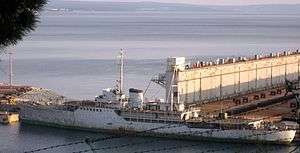Battle of the Strait of Otranto (1940)
The Battle of the Strait of Otranto was a minor naval skirmish on 12 November 1940 during the Battle of the Mediterranean in World War II. It took place in the Strait of Otranto in the Adriatic Sea, between Italy and Albania.
Background
The battle occurred when an Allied squadron entered the Adriatic Sea looking for Italian naval targets. Although they did not know it at the time the squadron's real purpose was to help draw enemy attention from a major action against the main Italian fleet base at Taranto (Battle of Taranto).[1] The Allied squadron was commanded by Vice Admiral Henry Pridham-Whippel in the light cruiser HMS Orion, and included the light cruisers HMAS Sydney and HMS Ajax and the destroyers HMS Nubian and Mohawk.
On 12 November, an Italian Navy (Regia Marina) convoy of four merchant ships—Antonio Locatelli, Premuda, Capo Vado and Catalani—were on their way back from Valona, Albania to Brindisi, Italy[2] while escorted by the World War I-era torpedo boat Fabrizi, commanded by T.V.c. Giovanni Barbini and the auxiliary cruiser Ramb III commanded by C.F. Francesco De Angelis. The ships were travelling darkened without navigational lights.
Battle
The Allied ships proceeded north during the night of 11 November, and upon reaching a notional line between Bari and Durazzo by 01:00 without incident, they turned to run southward. Twenty minutes later, the raiders encountered six darkened enemy ships, including what they thought were two destroyers and four merchantmen. The enemy vessels passed across their front and were making for the Italian mainland. HMS Mohawk opened fire at 01:27, and action became general.
In a confused night time action, HMAS Sydney attacked the leading freighter at a range of 11 km (5.9 nmi; 6.8 mi), setting it on fire. Over the next 23 minutes, the other three merchantmen were either sunk or damaged and left burning. Fabrizi was hit and heavily damaged, and limped toward Valona with 11 dead and 17 wounded. Ramb III after an initial discharge of 19 salvoes from her 120 mm (4.7 in) guns broke off the action unscathed. The merchantmen were all sunk in the action.
The Allies suffered no damage or casualties, although a torpedo narrowly missed Sydney's stern at 01:40. The Italians suffered 36 dead and 42 wounded.
Aftermath

The Italians retaliated by sending aircraft of the Regia Aeronautica to locate the British naval squadron; however, the CANT flying boats which eventually located the naval squadron were shot down. The Regia Marina sent motor torpedo boats located north of Valona, Cruiser Squadron 7, consisting of light cruisers Muzio Attendolo, Eugenio di Savoia, Emanuele Filiberto Duca d'Aosta, the 15th Destroyer Division from Brindisi, Cruiser Squadron 8, consisting of light cruisers Duca degli Abruzzi and Giuseppe Garibaldi, with the 7th and 8th Destroyer Divisions from Taranto sailed to intercept the British naval squadron in the Otranto Straits, but they failed to make contact.
The day after the battle, two Italian torpedo boats—Curtatone and Solferino—rescued a total of 140 sailors.
Order of battle
Regia Marina
- Captain Francesco De Angelis
- Torpedo boat Fabrizi (damaged)
- Auxiliary cruiser Ramb III
- 4 merchantmen, Antonio Locatelli (5,691 t (5,601 long tons)), Premuda (4,427 t (4,357 long tons)), Capo Vado (4,391 t (4,322 long tons)) and Catalani (2,429 t (2,391 long tons)) (all sunk)
Allies
- Rear Admiral Henry Pridham-Whippel
- 3 light cruisers: HMAS Sydney (Australian); HMS Ajax and Orion (British)
- 2 destroyers: HMS Nubian and Mohawk
Notes
- Coulthard-Clark 1998, p. 176.
- Jordan 2006, p. 226.
References
- Coulthard-Clark, Chris (1998). Where Australians Fought: The Encyclopaedia of Australia's Battles. St Leonards: Allen and Unwin. ISBN 1-86448-611-2.
- Gill, G Hermon (1957). Royal Australian Navy, 1939–1942. Australia in the War of 1939-1945 (1st ed.). Canberra: Australian War Memorial.
- Jordan, Roger (2006). The World's Merchant Fleets, 1939: The Particulars And Wartime Fates of 6,000 Ships. Annapolis: Naval Institute Press. ISBN 1-59114-959-2.
- (IT) Carlo Stasi, Otranto e l'Inghilterra (episodi bellici in Puglia e nel Salento), in "Note di Storia e Cultura Salentina", anno XV, (Argo, Lecce 2003)
- (IT) Carlo Stasi, Otranto nel Mondo. Dal "Castello" di Walpole al "Barone" di Voltaire (Editrice Salentina, Galatina 2018) ISBN 978-88-31964-06-7,
- Thomas P. Lowry, The Attack on Taranto (Stackpoole Books paperbacks, 2000)
_cropped.jpg)